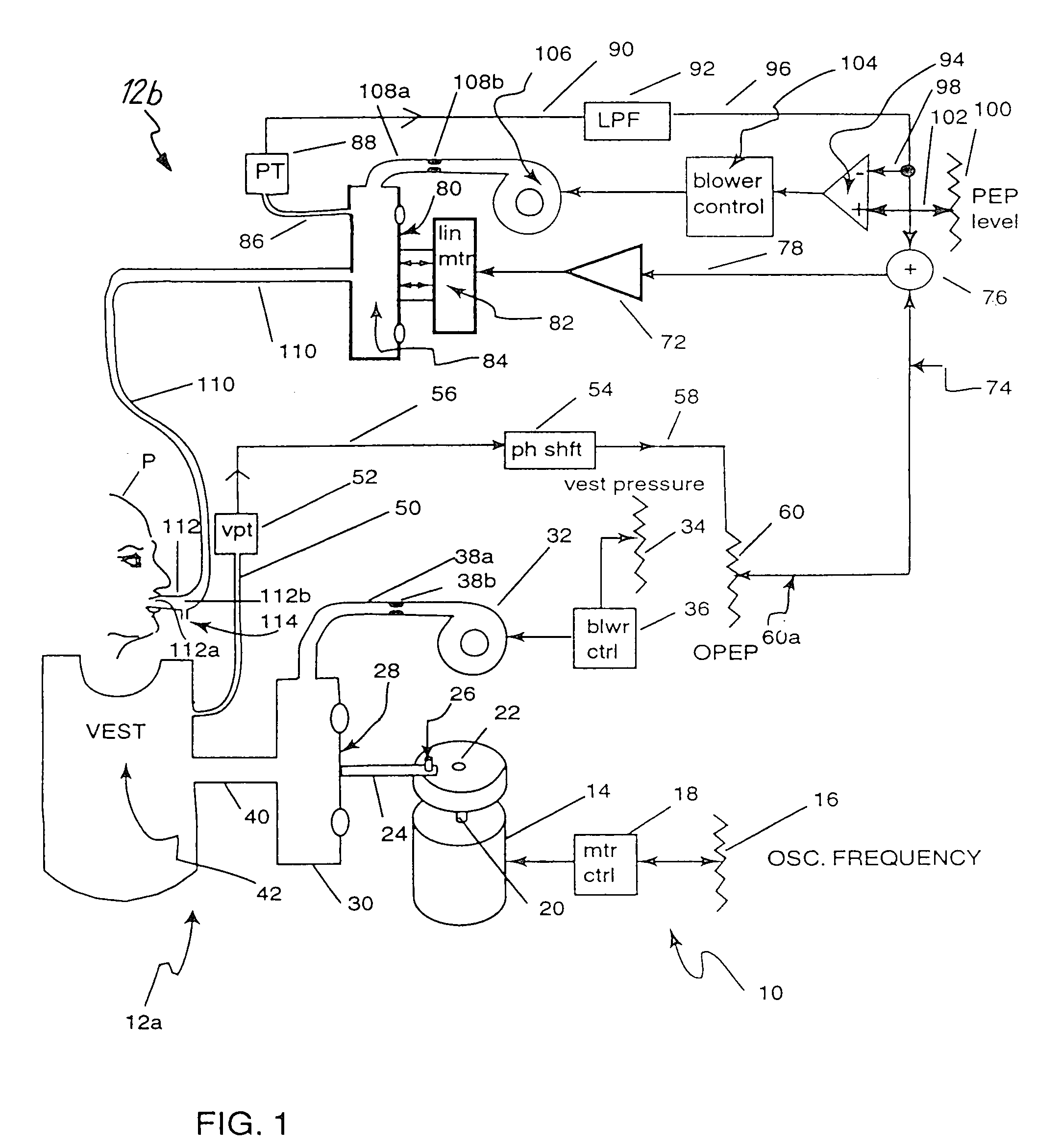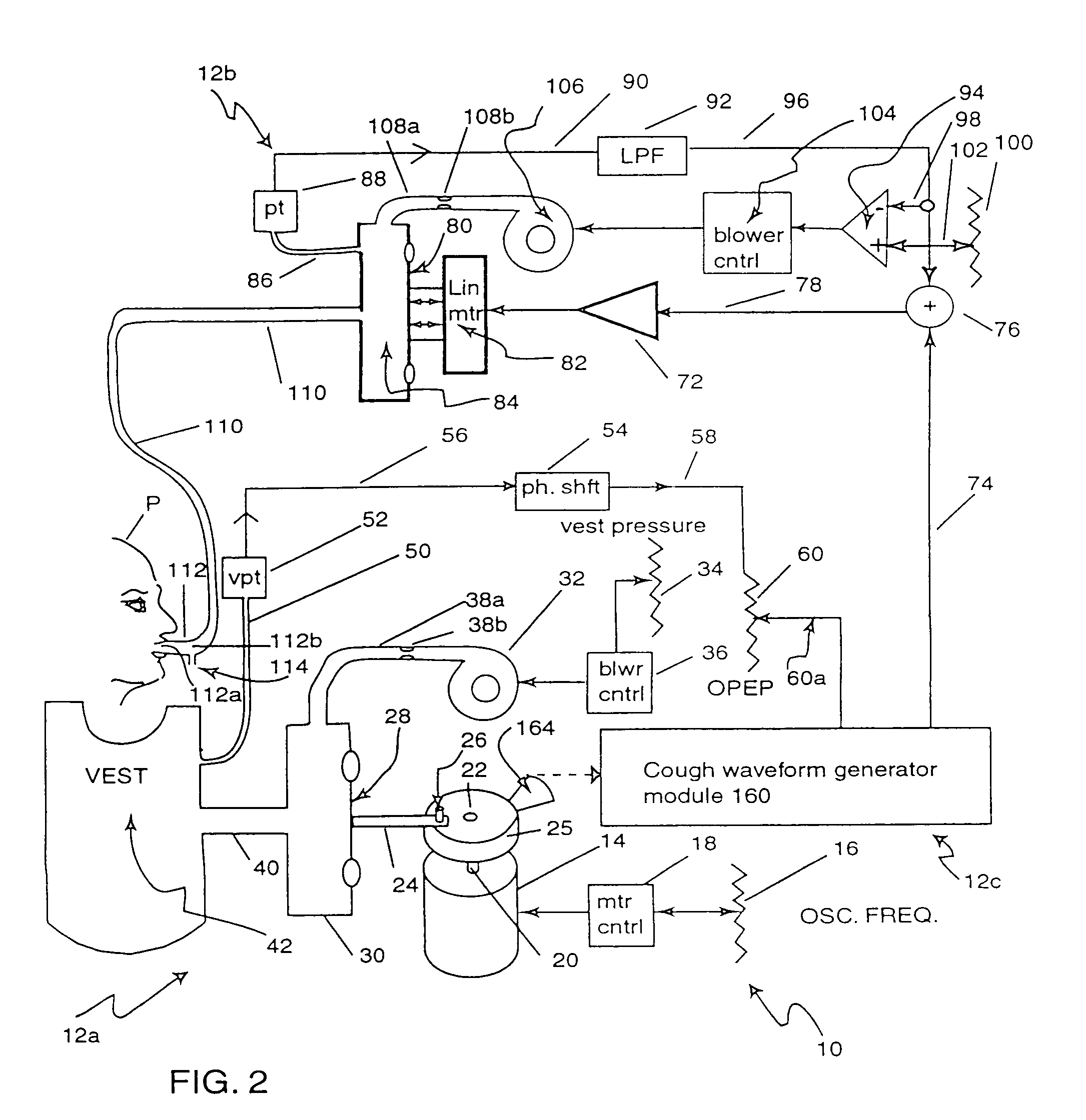Airway treatment apparatus with bias line cancellation
- Summary
- Abstract
- Description
- Claims
- Application Information
AI Technical Summary
Benefits of technology
Problems solved by technology
Method used
Image
Examples
first embodiment (fig.1)
FIRST EMBODIMENT (FIG. 1)
[0023]FIG. 1 is a block diagram showing a patient P undergoing treatment using the preferred embodiment of airway treatment apparatus 10. As shown in FIG. 1, apparatus 10 has two major subsystems, chest wall force applicator 12a (which applies oscillating compressive force to the chest of patient P) and air pressure input mouthpiece system 12b (which supplies air pressure to the patient's mouth in a relationship to the compressive force).
[0024]Chest wall force applicator 12a includes brushless motor 14, vest oscillation frequency potentiometer 16, motor controller 18, shaft 20, wheel 22, reciprocating arm 24, pin 26, diaphragm 28, air chamber 30, blower 32, vest pressure potentiometer 34, blower controller 36, tube 38a with constriction 38b, hoses 40, and inflatable vest 42. Oscillated air pressure is delivered to inflatable vest 42 to cause inflatable vest 42 to apply an oscillating force to the patient's chest.
[0025]Brushless motor 14 is operated by motor ...
second embodiment (
FIGS. 2–4B)
[0042]FIG. 2 shows a second embodiment of apparatus 10, having a simulated cough inducer 12c, which includes cough waveform generator module 160 and light interrupter 164. The embodiment shown in FIG. 2 is generally similar to the embodiment of FIG. 1, and similar reference characters are used to designate similar elements. FIG. 3 shows a schematic block diagram of cough waveform generator module 160, which includes optical sensor processor 166, cough waveform generator 168, line 170, cough intensity potentiometer 172, line 174, and summing junction 176.
[0043]Light interrupter 164 (FIG. 2) is attached to wheel 22 and sends signals to optical sensor processor 166. These components make up a diaphragm position sensor which is connected to cough waveform generator 168 via line 170. The output of cough waveform generator 168 is connected to Cough Intensity potentiometer 172. Line 174 connects Cough Intensity potentiometer 172 with one input of summing junction 176. Another in...
third embodiment (figs.5 – 8c)
THIRD EMBODIMENT (FIGS. 5–8C)
[0050]FIG. 5 shows a third embodiment of apparatus 10 which further includes airway resistance indicator 12d. The embodiment shown in FIG. 5 is generally similar to the embodiment shown in FIG. 1, and similar reference characters are used to designate similar elements. Airway resistance indicator 12d includes airway resistance module 200 (shown in FIG. 6), airway resistance null. detector / indicator module 210 (shown in FIG. 7) and test switch 220 (having terminals 220a–220c).
[0051]Airway resistance module 200 (FIG. 6) includes vest pressure transducer 52, phase shift network 54, lines 56 and 58, and PFT potentiometer 230, and lines 232 and 234. Vest pressure transducer 52 is linked to inflatable vest 42 by vest sampling tube 50. Phase shift network 54 is coupled to vest pressure transducer 52 via line 56. Line 58 connects phase shift network 54 with PFT potentiometer 230, which is connected to terminal 220a of test switch 220 by line 232. Line 234 couple...
PUM
 Login to View More
Login to View More Abstract
Description
Claims
Application Information
 Login to View More
Login to View More - R&D
- Intellectual Property
- Life Sciences
- Materials
- Tech Scout
- Unparalleled Data Quality
- Higher Quality Content
- 60% Fewer Hallucinations
Browse by: Latest US Patents, China's latest patents, Technical Efficacy Thesaurus, Application Domain, Technology Topic, Popular Technical Reports.
© 2025 PatSnap. All rights reserved.Legal|Privacy policy|Modern Slavery Act Transparency Statement|Sitemap|About US| Contact US: help@patsnap.com



